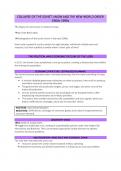1
COLLAPSE OF THE SOVIET UNION AND THE NEW WORLD ORDER
1960s-1990s
à collapse of communism in Eastern Europe
àfall of the Berlin Wall
àdisintegration of the Soviet Union in the early 1990s
How could a powerful country endure for eight decades, withstand mul@ple wars and
invasions, but then suddenly crumble within a short span of @me?
THE POLITICAL AND ECONOMIC DECLINE OF THE USSR
In 1917, the Soviet Union established a one-party system, crea@ng a dictatorship that ins@lled
fear among the popula@on.
ECONOMIC STRUCTURE: CENTRALIZED PLANNING
The Soviet economy operated under centralized planning, with the state controlling all major
aspects.
• It involves detailed government direc@ves on what to produce, how much to produce,
and where resources should be allocated.
• The government sets produc@on targets, prices, and wages, and owns most of the
means of produc@on.
• aims to achieve specific economic and social goals set by the government, oWen
emphasizing industrializa@on and military priori@es.
• This system lacks market mechanisms like compe@@on and price signals, which can
lead to inefficiencies, shortages, and a lack of consumer choice.
POSITIVES: rapid industrializa@on
NEGATIVES: inefficiencies, shortages of consumer goods, and a lack of responsiveness to
consumer demand.
LEADERSHIP CRISIS
1953: death of Joseph Stalin
à triggered a leadership crisis, leading to unpredictable policies under new leaders like
Khrushchev and Brezhnev. Their conserva@ve approaches lacked direc@on to address
economic and social problems.
MILITARIZATION: ARMS RACE AND ECONOMIC DRAIN
The Cold War intensified the arms race
• resources away from civilian sectors towards military spending.
à drained the economy and limited investments in infrastructure and social welfare.
, 2
ETHNIC TENSIONS: RISE OF NATIONALISM
• Na@onalist sen@ments are feelings of pride and loyalty towards one's own country or
ethnic group àPeople with na@onalist sen@ments believe in the importance of their
na@on's iden@ty, culture, and interests.
• Na@onalist sen@ments can lead to a desire for independence or autonomy for a
specific group within a country.
• They can also involve a strong dislike or distrust of other na@ons or ethnic groups,
some@mes leading to conflicts or tensions.
The Soviet Union comprised diverse ethnic groups, and abempts to promote a unified Soviet
iden@ty while suppressing na@onalist sen@ments led to tensions. Gorbachev's reforms
loosened state control, fuelling na@onalist movements and adding to the USSR's challenges.
The combina@on of repressive governance, economic inefficiencies, leadership crises,
militariza@on, and ethnic tensions eventually led to the collapse of the Soviet Union within
a few years.
STRATEGIC IMPORTANCE OF AFGHANISTAN TO THE USSR
à Afghanistan's proximity to the USSR's border made it strategically important.
Soviet aid to Afghanistan aimed to bring it into the Soviet sphere of influence +
counterbalance pro-American states (Turkey, Pakistan, Iraq, and Iran)
Muhammad Daud Khan's (leader of Afghanistan) leadership maintained @es with the USSR
but pursued an independent foreign policy.
à tried to play the two superpowers, the USA and USSR, off against each other
1978: Communist People's Democra@c Party overthrew Muhammad Daud Khan
à communist government: New gov = land reforms, leading to opposi@on from landowners +
clergy.
• Islamic revolu@on in neighbouring Iran sparked concerns about spreading to
Afghanistan and other Islamic republics within the USSR.
• The reason that USSR wanted control over Afghanistan was to have access over the
poor Muslim men so that they could be used in the Soviet armed forces
SOVIET INTERVENTION AND INTERNATIONAL RESPONSE
DECEMBER 1979: Soviet forces entered Afghanistan in ‘response’ to a request for help from
Afghan ruler Amin à USSR claimed that Amin said that these an@-communist groups were
rising up and USSR should send troops + get involved
1980:USA condemned (they stated it’s the wrong thing to do) the Soviet interven@on, culng
off grain sales to Russian and boycolng the Moscow Olympics
• America secretly funded Mujahideen fighters, escala@ng the conflict à American
military equipment, including S@nger surface-to-air missiles, were smuggled into
Afghanistan through Opera@on Cyclone




